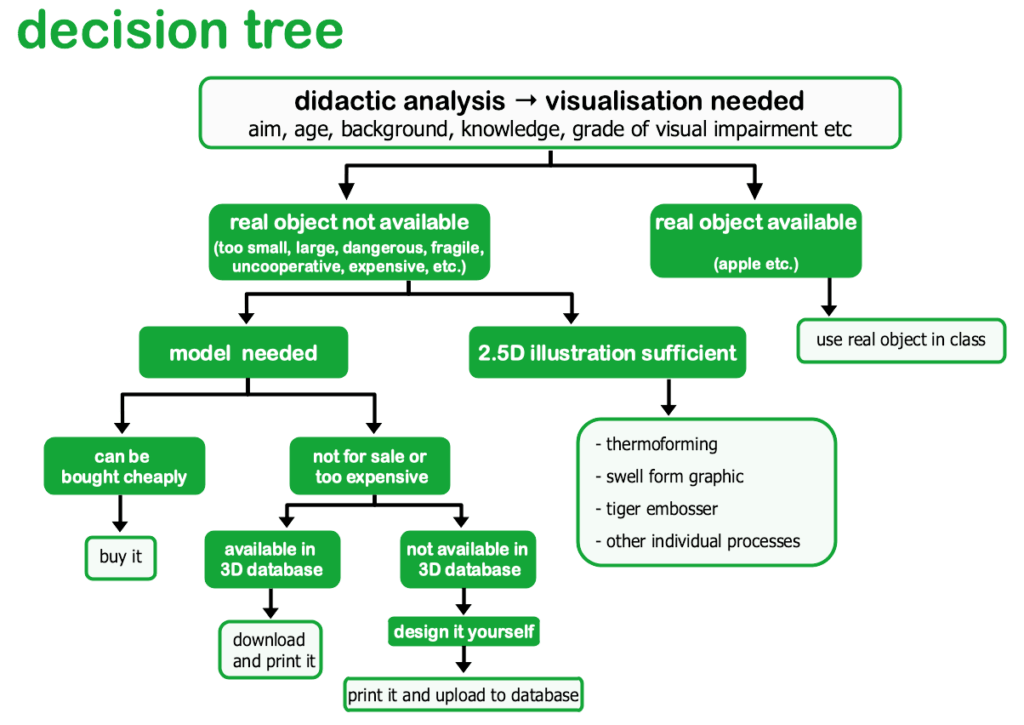Why 3D printing?
The relevance of using models in teaching visually impaired learners is undisputed. The existing methods of making these models however, often have the disadvantage of being very time-consuming, expensive, or challenging in terms of their craftsmanship. Producing a unique model out of materials such as wood, cardboard, foil, wire, toothpicks and so on can be very useful, and in many cases unavoidable, but it is not replicable.
In these times of increasing digitalisation and globalisation, however, this ‘traditional technique’ does not facilitate the exchange of models or allow many students to benefit from educationally valuable models.
This is where the advantages of 3D printing can be seen. In recent years, a number of schools, for example in the Netherlands, Germany and Spain, have developed and tested techniques for designing three-dimensional objects on a computer and using a 3D printer to turn these designs into real-world teaching tools for visually impaired learners. 3D printers are no longer in their infancy. They have entered the mainstream and can be purchased at prices starting from 200 Euros. The advantages are evident: models can be exchanged digitally and printed anywhere in the world at very low cost. A model thus only has to be designed once on the PC, which saves a huge amount of time compared with classic model building when printing out several prints. Further advantages of digital models lie in their scalability, for example enlarging important details of a model or highlighting certain sections. In addition, model series make it easier to model processes in different phases, for example, which goes beyond what folding models can offer.
When to use 3D printing?
Even though 3D printing offers a whole range of advantages in the construction of teaching materials, its use must still be well considered. Not every necessary model can be printed using a 3D printer, and even if 3D printing is technically possible, a number of other factors need to be considered and weighed up:
- Does the model already exist or must it first be designed on a PC ?
- For educational reasons, is there perhaps an original or something similar that is more suitable for teaching?
- What about the material costs and the time required to produce the model?
- Does the model require further components that cannot be produced in 3D printing? How do the components used fit together in this case?
- Can the model perhaps be purchased more easily and more cheaply?
The following decision tree may help answer the question of which method should ideally be used to produce the necessary visualisation.
There may of course be reasons to decide against the recommended technique of this decision tree. As with many guidelines there may be exceptions to the rule or the need for tailoring. For example, there may still be reasons for the educator to decide to print a model where there is an original available. Maybe there are specific features of the real object that one wants to highlight by the use of a model or there are educational aspects that require a printed model.
So, we encourage the educator to carefully weigh the choices above, bearing in mind that the most important consideration is that the model enables the student to reach the relevant learning objectives in the best possible way.
What are the guidelines?
When designing 3D models for teaching visually impaired learners, a whole range of educational and technical aspects have to be considered.
To ensure the quality of 3D printed educational materials for VI learners, different guidelines and instructions are required, such as instructions on the quality of the materials used. The same applies to other icons and graphic elements, such as arrows. How can those items best be represented? And what distance should be kept between two lines so that they can still be properly distinguished by touch? How do surfaces have to be designed so that they can be differentiated by touch? In 3D4VIP we have set ourselves the task of bringing together a set of guidelines specifically for VI educators.
We have developed these guidelines to support designers with a set of proven design rules, techniques and solutions, because we are convinced that the design process will be simplified with their help. At the same time, the guidelines will hopefully contribute to quality improvement and, to a certain extent, to standardisation in the construction of teaching materials across Europe.
This document starts with a summary of the principles for the development of teaching materials. This is especially interesting for people who are not familiar with the teaching of visually impaired people.
In the main part of the guidelines, suggestions and solutions are given on how to design regularly occurring components and aspects of models, such as line and dot symbols, braille, textures, arrows, etc.
The next chapter highlights a number of factors that should be considered when printing 3D models specifically for visually impaired learners.
In the following chapter, we look at solutions to various recurring problems and best practice style solutions.
The final part of the guidelines is the chapter on post processing. These are techniques and procedures that are applied after the model has been printed. Examples are the smoothing and painting of the surface, the use of adhesives and magnets and also the addition of further information by NFC tags and much more.
Who are the guidelines intended for?
The guidelines are aimed at two different groups of people in particular, who work in the context of 3D printing for visually impaired learners.
In order to describe these groups more clearly, fictional characters were devised, each representing one of the target groups.
Maggie

Maggie is a teacher who has a few spare hours in addition to her teaching job at the school for visually impaired learners. She is aware of what the students need to know. Maggie loves learning new things and is interested in 3D printing. She knows how a printer works and can print a model.
When Maggie wants to start designing her own models, she is interested in getting tips and tricks. Maggie knows in principle what models for visually impaired learners should look like. But she does not yet know, for example, which dot and line symbols can be used with the 3D printer. She gets all this information and more tips from the guidelines.
Sophia

Sophia is a designer and 3D printing expert. She has a technical background. She discovered 3D printing a few years ago and loves experimenting with the technology. She knows how to sculpt a product, knows her printers and the software that goes with them. Sophia knows nothing or little about visually impaired people, but wants to develop good educational materials.
As she wants to develop these new materials for visually impaired people, she needs the guidelines and all the information. In the guidelines she finds many principles of what models should look like for visually impaired learners. This helps her design the models. She is an expert but she still needs to read through the same chapters as Maggie. Even though she can design and print wonderful models, there is expertise and specific design rules to follow when designing models for visually impaired people. She will need these to design and print models that are suitable for the students.
The individual subtopics of the guidelines are of different interest to Maggie and Sophia. As a teacher and expert in working with VI students, for example, the topics relating to size of models or didactic reduction are less interesting for Maggie since these form basic knowledge in her job. For Sophia, on the other hand, these aspects are fundamental when designing models. She may not need to read articles about subtopics such as wall thickness and support. However, many topics, such as Braille on 3D printed models, are interesting for both of them because they only exist in the combination of teaching VI learners and 3D printing. We have taken the interests of both type of users into account when producing our guidelines.
How did the guidelines come about?
The 3D4VIP project’s guidelines were written by several experts from the different participating institutions. The essays were written based on a wide range of experience and vast knowledge of the team members. In addition, the guidelines were evaluated using test objects with visually impaired learners. The VI students are the experts. They know what feels good and what does not, depending on the information that needs to be learned.
Existing guidelines were also used as a reference. The problem with the existing guidelines was that they are not complete. Each guideline document has its own focus. They did not offer the hoped-for breadth and depth despite their large number. It was therefore possible to obtain input from the various guidelines, but none of the essays could be taken over in its entirety. These guidelines should therefore be considered as an attempt to bring together all the important features to consider in the field of printing educational materials for VI students.
How are the articles structured?
As the individual essays are devoted to completely different topics (e.g. educational vs. technical issues), there can be no universal structure to them. In principle, they are structured in such a way that after a short introduction, the relevant tips are given on how to solve the particular problem or how to construct the model in concrete detail. A practical approach to the topic is assumed here. Therefore there is no focus on theoretical backgrounds, as the guidelines are meant to be a tool for action.
All hints and tips presented are based on extensive testing and the contents of the existing guidelines.
How did the articles come about and why should I trust them?
All articles were written by authors who know the subject very well. On the one hand, there are teachers for the visually impaired who have many years of experience in teaching visually impaired learners. They also have knowledge in the field of 3D printing. In addition, articles with an educational background, such as Article 3.4 Braille, were written in collaboration with visually impaired learners. In this specific case, various sample prints were created which were evaluated by students as a part of a small study. In the case of Braille, experiments were made with Braille. The legibility of the individual dots of braille was also tested: when they are rounded like hemispheres or when they are printed as cylinders.
Experts in the field of 3D printing have also written articles, such as article 6.8 Topology in 3D meshes. There are technical articles that required test materials and those that did not. Often the article itself refers to the tests and the conclusions.


